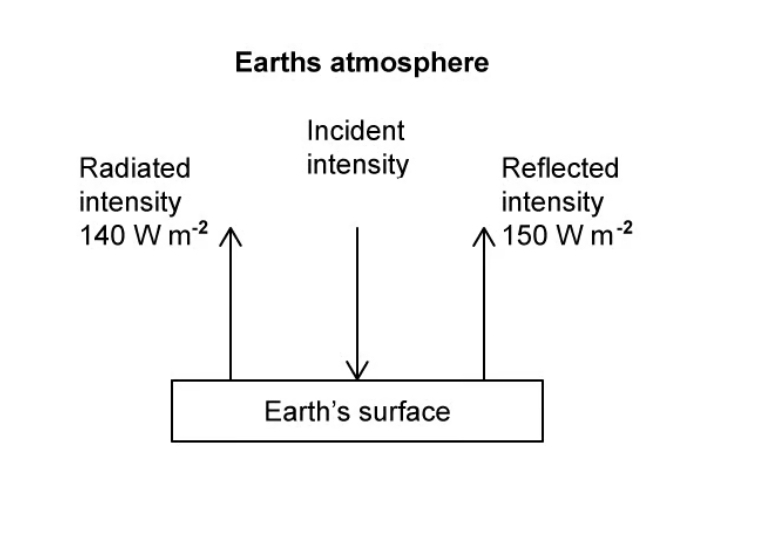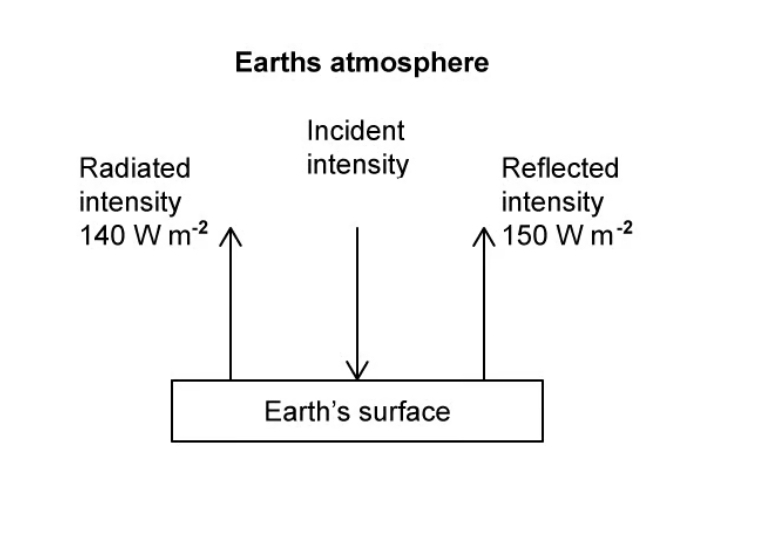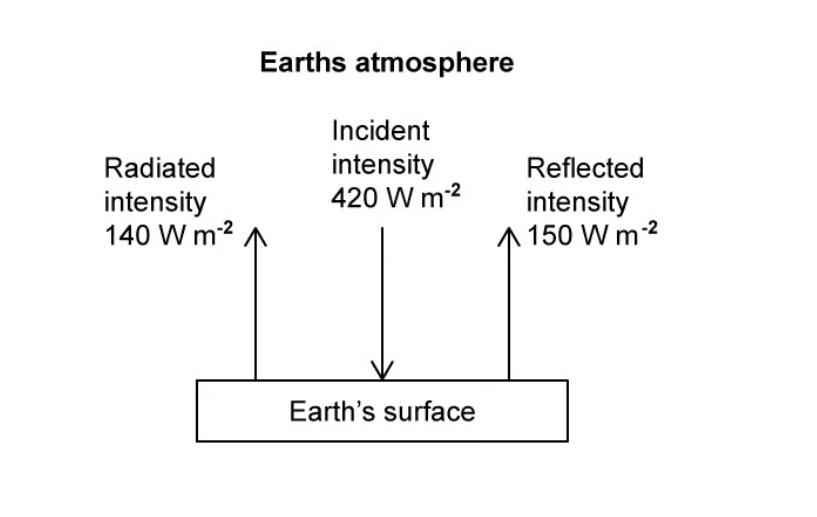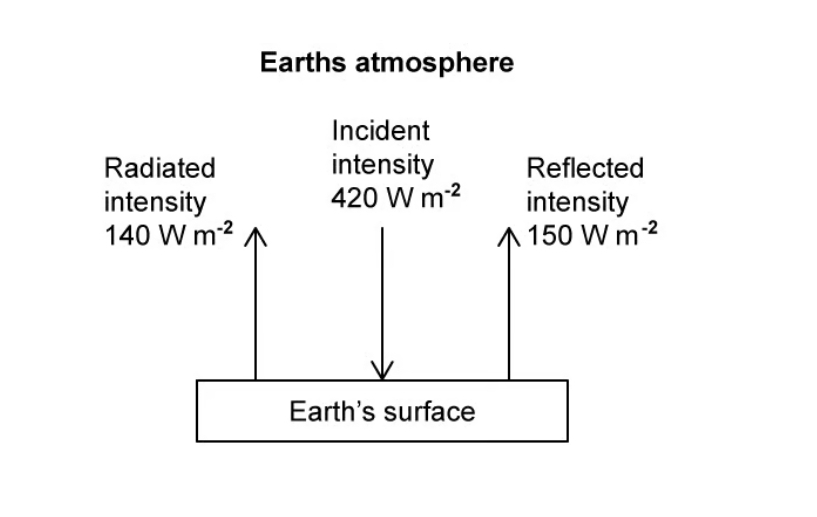B.2 Greenhouse Effect
1/35
Earn XP
Description and Tags
Name | Mastery | Learn | Test | Matching | Spaced |
|---|
No study sessions yet.
36 Terms
Define emissivity.
Emissivity is the ratio of the power radiated per unit area by an object compared to that of an ideal black body at the same temperature.
State the equation for emissivity.
The equation for emissivity is e = I / I_b
What assumptions do emissivity calculations make?
Emissivity calculations make the following assumptions:
the black body is at the same temperature as the object
the black body has the same dimensions as the object
What is the emissivity value for a perfect black body?
The emissivity value for a perfect black body is 1.
State the Stephan-Boltzmann law equation for an object which is not a black body.
The Stephan-Boltzmann law for an object that is not a black body is given by: ( E = e \sigma T^4 ), where (E) is the emitted energy, (e) is the emissivity, (\sigma) is the Stefan-Boltzmann constant, and (T) is the absolute temperature.
Define albedo.
Albedo is the ratio of the total scattered power to the total incident power of radiation on a surface.
State the equation for albedo.
The equation for albedo is a = \frac{P{scattered}}{P{incident}}
State one factor that affect the albedo of Earth.
The three factors that affect the albedo of Earth are:
cloud formations due to seasons and day
latitude
terrain
incident angle on the surface of the Earth
The Earth has an albedo of 0.3. What does that represent?
An albedo of 0.3 means that 30% of the radiation from the Sun that reaches the Earth's surface is reflected back into the atmosphere.
What does an albedo of 1 represent?
An albedo of 1 will represent a surface which scatters all incident radiation.
Define the solar constant.
The solar constant is the intensity of the Sun's radiation arriving perpendicularly on the Earth's atmosphere when the Earth is at its mean distance from the Sun.
Give one reason why the solar constant varies throughout the year.
Reasons why the solar constant varies throughout the year are:
the elliptical orbit of the Earth means that Earth differs in its distance from the Sun
the Sun's output varies during its sunspot cycle
What assumptions do solar constant calculations make?
Solar constant calculations make the following assumptions:
solar radiation is incident on a plane perpendicular to the Earth's surface
the Earth is at a mean distance from the Sun
True or False?
Different planets have different solar constants.
True.
Different planets have different solar constants because they are different distances away from the Sun.
What is the mean value of the radiative power or intensity?
The mean value of the radiative power or intensity is
S/4
What are the main greenhouse gases?
The main greenhouse gases are:
water vapour (H2O)
carbon dioxide (CO2)
methane (CH4)
nitrous oxide (N2O)
Which of the main greenhouse gases is most sbundant in the atmosphere?
The greenhouse gas that is most abundant in the atmosphere is water vapour.
What is a greenhouse gas?
A greenhouse gas is a gas that absorbs re-radiated radiation, trapping the radiation in the Earth's atmosphere.
Which greenhouse gases contribute the most to the greenhouse effect?
The greenhouse gases that contribute most to the greenhouse effect are:
carbon dioxide (CO2)
water vapour (H2O)
True or False?
Ozone absorbs almost 100% of incoming UV radiation.
True.
Ozone absorbs almost 100% of incoming UV radiation. Ozone also absorbs outgoing infrared radiation.
True or False?
Carbon dioxide absorbs infrared radiation.
True.
Carbon dioxide strongly absorbs infrared radiation at 15μm.
True or False?
Water vapour absorbs infrared radiation.
True.
Water vapour absorbs infrared radiation.
True or False?
Increasing concentrations of ozone in the atmosphere are significantly contributing to the greenhouse effect.
False.
Increasing concentrations of carbon dioxide in the atmosphere are significantly contributing to the greenhouse effect. The concentration of ozone in the atmosphere is too low to significantly contribute to the greenhouse effect.
True or False?
Most of the radiation reaching Earth from the Sun is ultraviolet and visible light.
True.
Most of the radiation reaching Earth from the Sun is ultraviolet and visible light.
True or False?
Visible light is absorbed by the atmosphere.
False.
Visible light is not absorbed by the atmosphere; it is absorbed by the Earth's surface. At night, the Earth re-radiates this energy as infrared radiation.
Describe the process of global warming using the resonance model.
The process of global warming using the resonance model is as follows:
visible light is absorbed by the Earth's surface in the day
the energy is re-radiated as infrared during the night
some of the infrared is reflected out to space
some of the infrared is absorbed by greenhouse gases
greenhouse gases reflect the infrared back to Earth
heat energy becomes trapped inside the Earth's atmosphere
True or False?
According to the molecular energy level model, high-frequency UV light causes atoms to vibrate.
False.
High-frequency UV light breaks molecular bonds. It is infrared radiation that causes atoms to vibrate.
True or False?
According to the molecular energy level model, greenhouse gases have a natural frequency close to that of infrared, so when they absorb infrared radiation, they resonate, causing the molecules to heat up.
True.
According to the molecular energy level model, greenhouse gases have a natural frequency close to that of infrared, so when they absorb infrared radiation, they resonate, causing the molecules to heat up.
Give one example of human activity that has led to an increase in carbon dioxide in the atmosphere.
Examples of human activity that have led to an increase in carbon dioxide in the atmosphere are:
burning fossil fuels
burning wood
deforestation
Give one example of human activity that has led to an increase in methane in the atmosphere.
Examples of human activity that have led to an increase in methane in the atmosphere are:
decay of organic matter
farming
Give one example of human activity that has led to an increase in nitrous oxide in the atmosphere.
Examples of human activity that have led to an increase in nitrous oxide in the atmosphere are:
artificial fertilisers
burning fossil fuels
True or False?
If the Earth's incoming and outgoing energy is balanced, then the temperature of the Earth will rise.
False.
If the Earth's incoming and outgoing energy is balanced, then the temperature of the Earth will remain constant.

For the Earth's temperature to remain constant, what would the value of incident radiation need to be?
For the Earth's temperature to remain constant, the incident radiation would need to be 290 W m–2.
Incident intensity = 140 + 150


In the scenario shown in this energy balance diagram, explain whether the temperature of the Earth's atmosphere increases, decreases or stays the same.
In the scenario shown in this energy balance diagram, the temperature of the Earth's atmosphere increases because the incident intensity is greater than the outgoing intensity.
